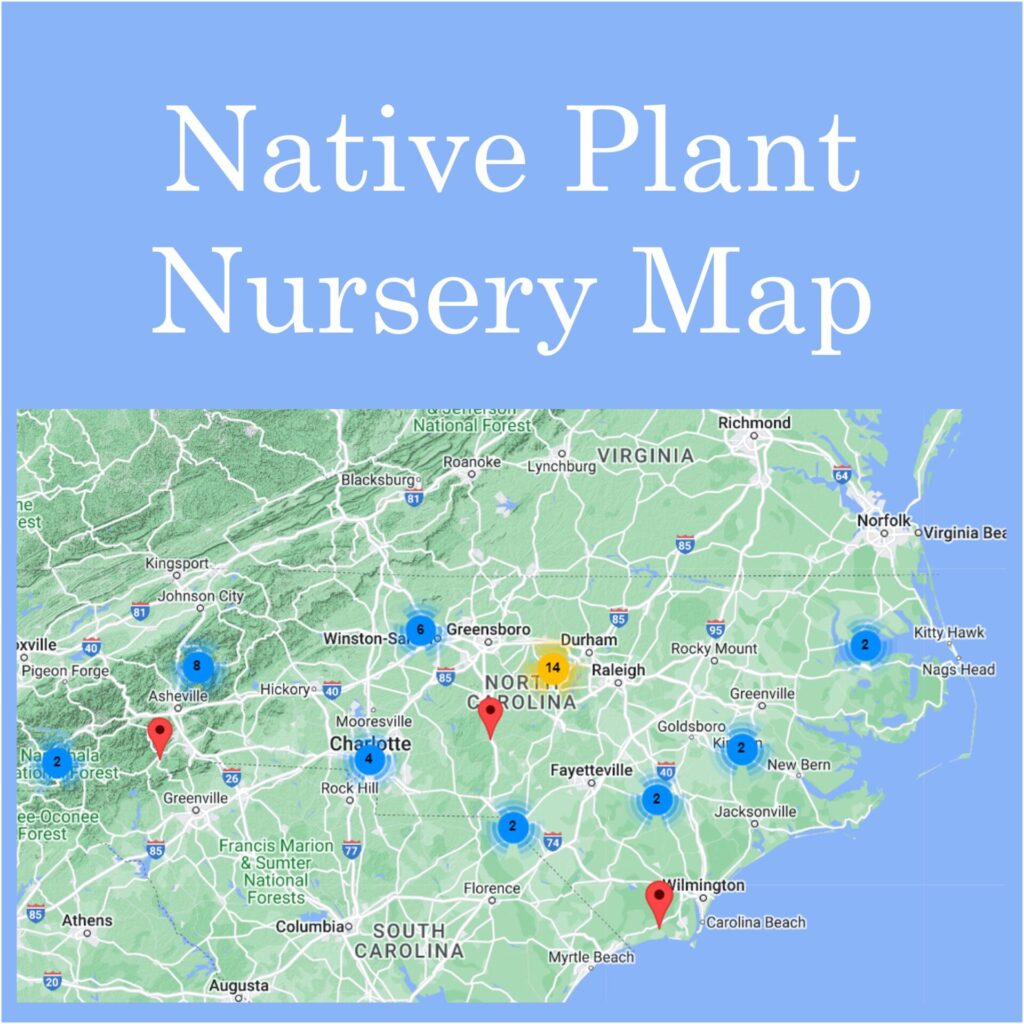By Bill Jones reporting for Native Plant News
The North Carolina Native Plant Society asked Carolina Native Nursery to offer our perspective regarding the passing of what many call the NC Native Plants Act. Since its passage, we have attended a small conference to discuss it, heard from some of our fellow nursery owners, and had some time to reflect and gather more information. We can also add some perspective on how native plants fit into the horticulture industry as a whole.
Carolina Native Nursery was thrilled when Senate Bill 606 was signed into law by Gov. Roy Cooper on July 22, 2023. We were aware of this effort in 2022 when it originally passed the senate but got stalled in the House. It will require the N.C. Department of Transportation to select plants with “a strong preference” for native species when landscaping highway rights of way beginning in January 2024. “North Carolina’s native plants are indigenous plants that have adapted over many years to our region and evolved to flourish in the unique geography, hydrology, and microclimates of our State,” the bill reads. “(G)ardens and landscapes composed of North Carolina’s native plants require little or no fertilizers, soil amendments, or pesticides and use less water.” Sounds good to us.
We reached out to the North Carolina Nursery & Landscape Association to get their perspective. The NCNLA Legislative Committee states: “NCNLA appreciates native plants and plants in general regardless of origin for the unique functions they provide to the environment. Native-only mandates do concern us as they limit flexibility of planting choices and can have unintended negative consequences for our membership. Given those concerns, compromise legislation was drafted that kept the native plant mandate for NCDOT right-of-way projects but allowed for a phase-in period, cultivars of native species that do not have reduced reproductive structures and expanded the definition of acceptable native plants to include a larger portion of the southeastern US.” It is important to remember that the association did not reach out to all its members in drafting this or in its lobbying efforts. Nor does it reflect the opinions of all its members. Carolina Native Nursery is a member in good standing, has been for over 20 years and is the largest native plant nursery in North Carolina, well-known doing business throughout the state. We were never asked for comments or information nor did we know lobbying efforts were taking place.
Do nurseries have much reason to bring natives to market?
In February we attended a small conference at the Raulston Arboretum in Raleigh that brought together a diverse group of individuals. The group included nursery owners and managers, NCDOT and other government agencies, landscape architects and designers, folks from public and private gardens, and others with interest in horticulture. The panel discussions were: Why Natives, why now?; Toward Understanding Where Natives Fit into Modern Landscapes, and Natives in the Nursery & Greenhouse Industry: Realities of Growing Supply. Bill Jones from Carolina Native Nursery participated in the last panel. Overall, the discussions were good and to the point. Some of the main takeaways of this multi-group conference were these:
- The nursery industry runs at a rather full capacity
- Nurseries are happy with the line of plants they grow so do not see much reason to bring on new lines (natives would be new)
- Consequently nurseries do not have much reason to bring more natives to market.
- Also we heard that natives make up 14% of horticulture sales in North Carolina to the tune of $29 million. These data were not sourced.
What is the importance of native plants?
But throughout the day, in every discussion, little was said about the why–“Why Natives, why now?” Some reasons to use native plants are the crucial ecological services they provide such as balancing ecosystems, helping restore the wild that surrounds us, and preventing species extinction. Overall, we thought the meeting did not work to bring about a better understanding of why native plants are so important to ecological preservation, which in essence was the purpose of the legislation in the first place.
In reviewing the initial feedback, the meeting’s takeaways show confusion and misunderstanding. It appears that many do not know where natives fit in the plant marketplace, where the marketing and demand come from, and are defensive because of it. We have seen this before so it is not a surprise.
Carolina Native is in its 21st year as an active part of the horticulture industry in North Carolina and the eastern U.S. We serve wholesale and retail clients from Atlanta to Maine. We’d like to offer a few insights into this subject.
As stated before, the nursery industry runs at a fairly full capacity. While some nurseries are expanding and consolidating, they will continue to grow the plants that they are successful with–mainly the branded product lines. It works for their business, they know it, and it is profitable. Little, if any, attention is paid to the fact that the vast majority of these plants provide no support to local ecosystems. Again, no birds, no bees, and no butterflies means no ecosystems support. Ecosystem support is not part of their business plan.
An uptick in awareness
With that being said, we have seen an uptick in native awareness in the industry overall. As we do every year, we participate in both the MANTS Show (Mid-Atlantic Nursery Trade Show) in Baltimore as well as the Green & Growin’ trade show (of the NC Nursery & Landscape Association) in Greensboro. At the MANTS Show in particular we saw many more nurseries start to show natives as part of their inventory. And they came to talk with us. Not so much at Green & Growin’. It appears that many in the Mid-Atlantic region as well as the Northeast are seeing an awareness and demand and are responding accordingly.
Back in North Carolina, some of these individual DOT projects need well over 100,000 plants in a short period of time. These numbers can highlight the problem. No one nursery or even a group of them has that number of plants waiting. Projections are made for current demands and spread across a wide variety of clients, not for a particular job. Meeting the demand for native plants that will start occurring across our state is going to be very difficult. When one line of plants (non-native) is suddenly to be replaced with another (native), our industry will be slow to adjust. In fact, it may take years. The overall numbers start at the liner phase (the young plants usually grown from cuttings or tissue culture) and are grown at those nurseries. Again, the liner nurseries are at full capacity and many grow few natives or none at all. Carolina Native sees first hand how difficult it is to expand the numbers of plants on the ground.
It really is a huge step in the right direction that our state made a wonderful move through this groundbreaking legislation. And the fact that there was support across the aisle by a huge majority of our legislature and our governor should make us all happy. It is going to be hard for the horticulture industry to adjust to these new demands in the short term. But as demand increases for native plants from many directions, the horticulture industry will respond in kind. Carolina Native Nursery welcomes all efforts to get more native plants in the ground and looks forward to the day when all our friends in the nursery industry grow the millions needed to do the job.

Bill Jones founded Carolina Native Nursery in 2003 to help preserve the ecological communities of western North Carolina as well as the eastern U.S. Active in community environmental activities, he is a member of North Carolina Native Plant Society, the NC Nursery & Landscape Association, International Plant Propagators Society, the Perennial Plant Association, and the Sierra Club. He has presented at the Cullowhee Native Plant Conference, Green & Growin’ Educational Conferences, and other groups that focus on how native plants are critical to helping our landscapes and earth thrive.
Editor’s Note: To see the nurseries listed by the NC Native Plant Society, click here. Customers should endeavor to verify they’re buying native species. Nursery plants must be identified by common and botanical names. Also, see “A Partnership Bears Fruit,” and “Greensboro, the First NC City with a Native Plants Policy,” Native Plant News Summer 2024.

